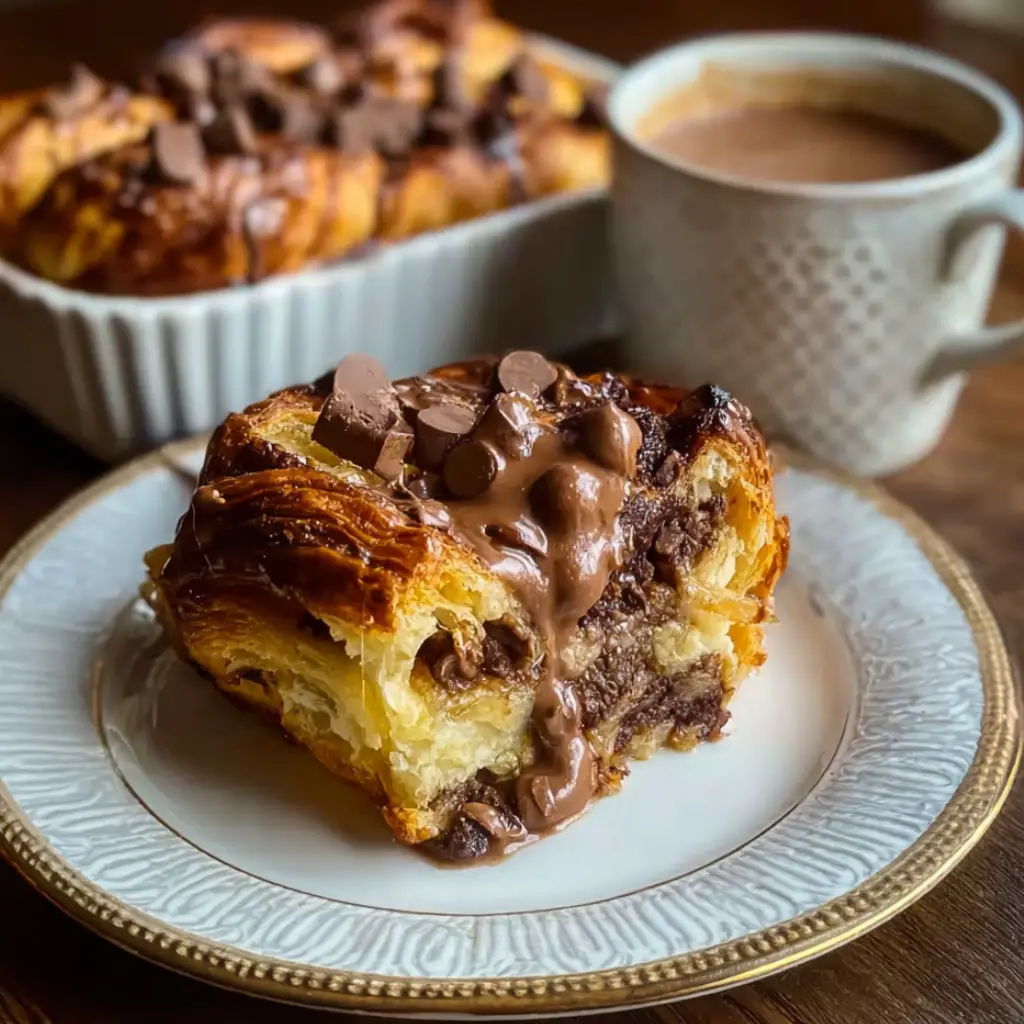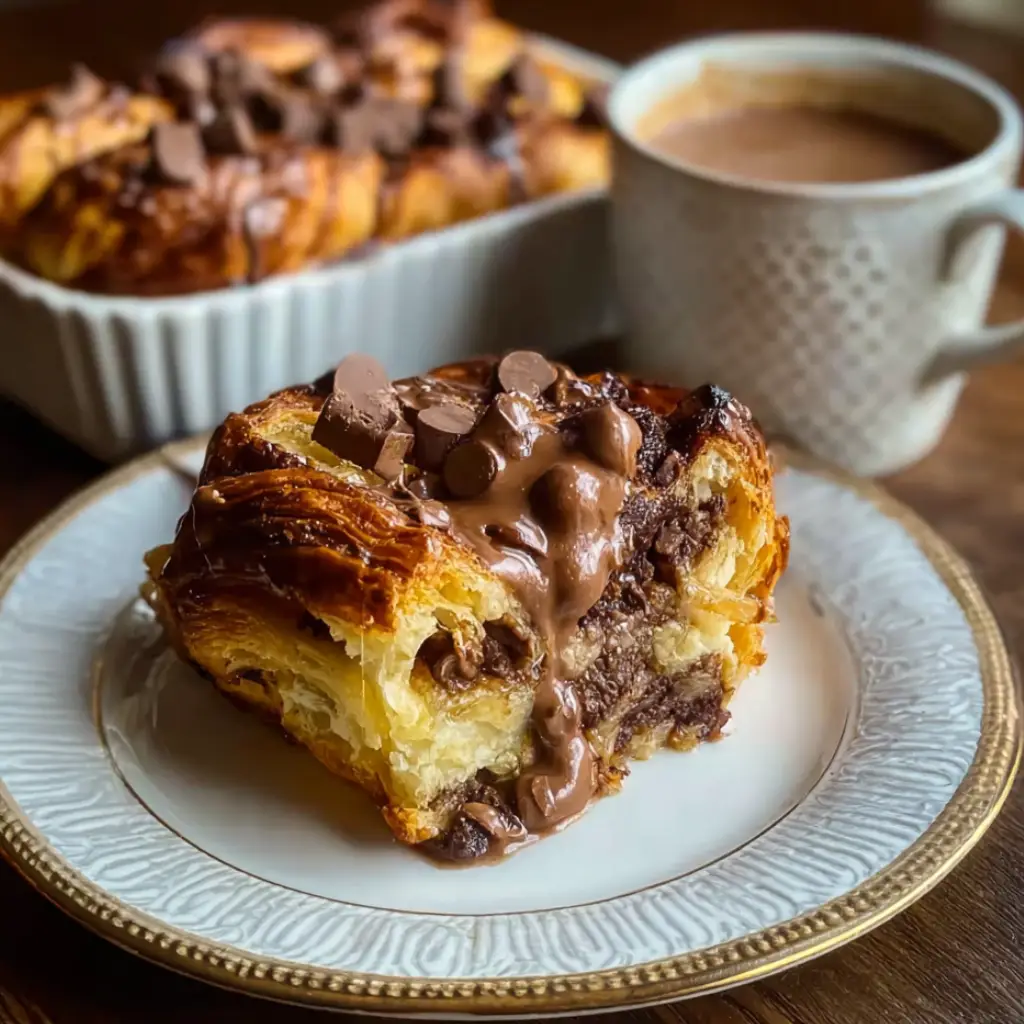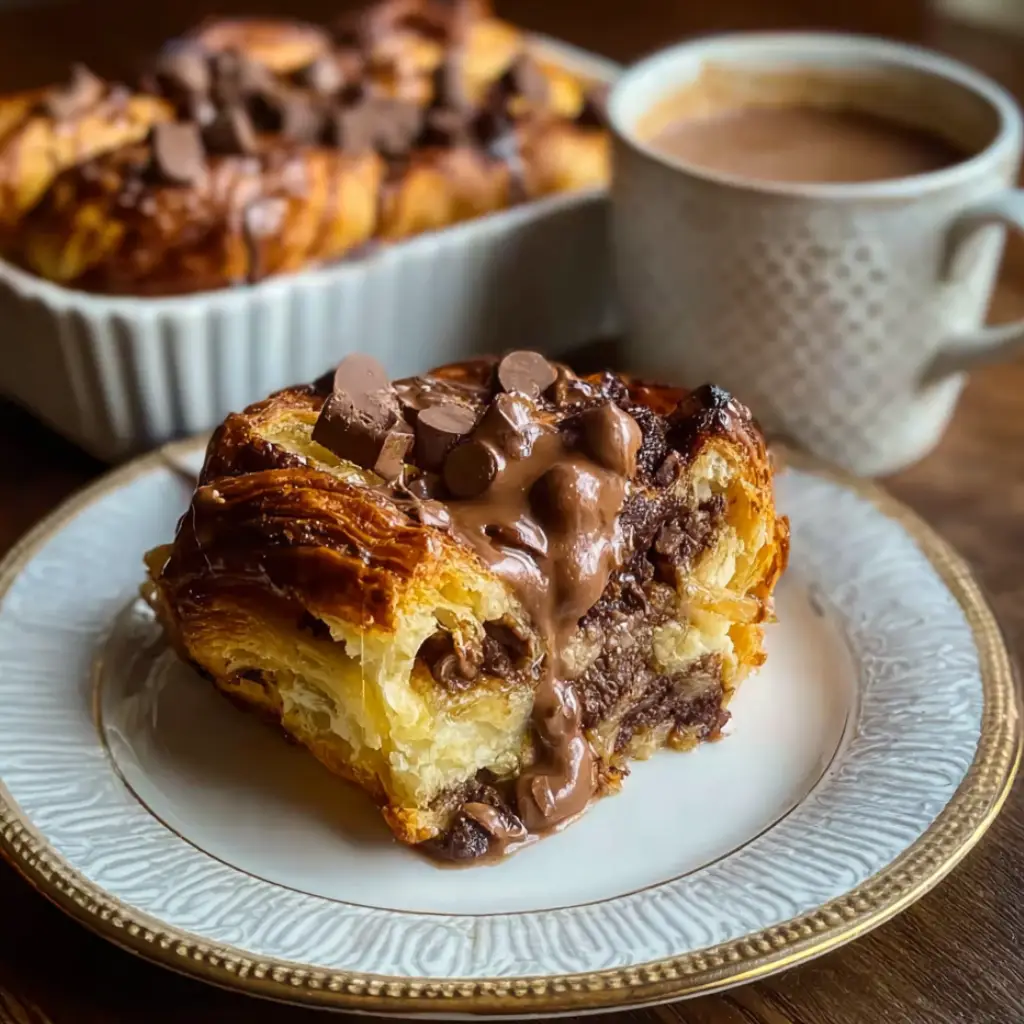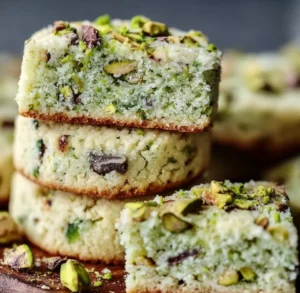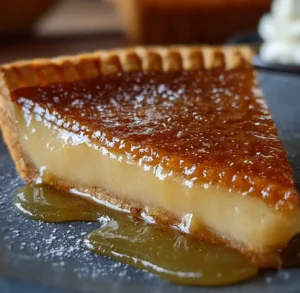| Prep Time: 15 minutes | Cook Time: 40 minutes | Total Time: 55 minutes | Serves: 8 |
|---|
Why Chocolate Croissant Breakfast Bake Deserves Your Morning Attention
The chocolate croissant breakfast bake represents the perfect marriage of convenience and sophistication because it delivers restaurant-quality results using simple ingredients that most home cooks already have in their pantries, while requiring minimal hands-on preparation time that allows you to focus on enjoying precious moments with loved ones rather than slaving over a hot stove. This extraordinary dish solves the common problem of feeding multiple people a satisfying breakfast without the stress of individual preparation because everything bakes together in one beautiful casserole that emerges from the oven golden, fragrant, and ready to create memorable dining experiences.
The versatility of this chocolate croissant breakfast bake makes it incredibly appealing to busy home cooks because it can be assembled the night before and simply popped into the oven the next morning, making it ideal for holiday gatherings, overnight guests, or weekend brunches where you want to appear effortlessly organized while actually being incredibly well-prepared. The combination of textures in this dish creates a sensory experience that appeals to all ages because the custard-soaked croissants become tender and custardy while maintaining crispy edges, and the melted chocolate chips provide delightful pockets of sweetness throughout every serving.
What makes this recipe particularly special is its ability to transform humble grocery store croissants into something that rivals the finest bakery offerings because the overnight soaking process allows the croissants to absorb the rich custard mixture while maintaining their distinctive flaky character, creating a depth of flavor and texture that simply cannot be achieved through other breakfast preparation methods.
Essential Ingredients for Perfect Chocolate Croissant Breakfast Bake
Creating the perfect chocolate croissant breakfast bake requires carefully selected ingredients that work together harmoniously to achieve the ideal balance of richness, sweetness, and texture because each component plays a crucial role in delivering the luxurious dining experience that makes this dish so memorable and sought-after.
Day-Old Croissants – 8-10 large bakery croissants, preferably slightly stale, form the foundation of your breakfast bake because day-old croissants absorb the custard mixture more effectively than fresh ones while maintaining enough structure to create the perfect texture contrast between tender interior and golden exterior.
Cream Cheese – 8 ounces of full-fat cream cheese, softened to room temperature, creates the luxurious base for your custard because this ingredient provides richness and tang that balances the sweetness while contributing to the creamy texture that makes each bite incredibly satisfying.
Large Eggs – 4 whole eggs bind the entire dish together because they provide structure and protein that transforms the mixture from liquid into a cohesive, custard-like consistency that holds everything together beautifully while adding nutritional value.
Whole Milk – 1 cup of whole milk creates the proper consistency for your custard base because the fat content contributes to richness while the liquid ensures proper absorption into the croissant pieces, creating the ideal texture throughout the finished dish.
Granulated Sugar – 1/2 cup of granulated sugar provides the necessary sweetness that complements the chocolate elements because this ingredient balances the tanginess of the cream cheese while enhancing the natural flavors of the other components.
Pure Vanilla Extract – 2 teaspoons of high-quality vanilla extract adds aromatic depth because this ingredient enhances all the other flavors while providing the warm, comforting notes that make breakfast baking so appealing to everyone at your table.
Semi-Sweet Chocolate Chips – 1 cup of semi-sweet chocolate chips creates delightful pockets of melted chocolate throughout the bake because these morsels maintain their shape during baking while becoming perfectly gooey and providing bursts of rich chocolate flavor in every bite.
The Art of Creating Perfect Chocolate Croissant Breakfast Bake
Mastering the chocolate croissant breakfast bake requires understanding the delicate balance between preparation technique and timing because even the most premium ingredients can disappoint if not handled properly, while simple grocery store components can create extraordinary results when treated with care and attention to detail.
The foundation of exceptional chocolate croissant breakfast bake begins with selecting the right croissants because day-old or slightly stale croissants from your local bakery absorb the custard mixture more effectively than fresh ones, creating the perfect texture that is neither too soggy nor too dry when the baking process is complete. Temperature management plays a crucial role in achieving optimal results because room temperature cream cheese blends smoothly without lumps, while cold eggs can cause the mixture to become chunky and uneven.
Timing becomes essential when preparing this dish because the croissants need adequate time to absorb the custard mixture, typically requiring at least twenty minutes of soaking time or, preferably, an overnight rest in the refrigerator that allows flavors to meld and develop complexity. The visual presentation contributes significantly to the overall dining experience because a properly prepared chocolate croissant breakfast bake emerges from the oven with a golden-brown surface that creates anticipation and excitement among everyone gathered around your breakfast table.
Understanding the science behind custard formation helps ensure consistent results because the eggs and dairy must reach the proper temperature during baking to set into the creamy, pudding-like consistency that defines this dish while avoiding the overcooking that results in rubbery or curdled textures.
Step-by-Step Instructions for Chocolate Croissant Breakfast Bake Mastery
Follow these detailed instructions to create a chocolate croissant breakfast bake that will become the star of every breakfast gathering because proper technique ensures consistent results and maximum flavor impact with every batch you prepare.
Step 1: Prepare Your Baking Environment Preheat your oven to 350 degrees Fahrenheit and generously grease a 9×13-inch baking dish with butter or cooking spray because proper preparation prevents sticking and ensures easy serving. Position your oven rack in the center position because this placement provides even heat distribution that prevents overcooking on the bottom while ensuring proper browning on top.
Professional Tip: Allow your cream cheese to reach room temperature naturally rather than using the microwave because gradual warming preserves the smooth texture that creates the perfect custard base.
Key Points: The baking dish should be thoroughly coated to prevent any portion of the breakfast bake from adhering to the sides, and room temperature ingredients blend more easily than cold ones.
Step 2: Prepare Your Croissants Tear your day-old croissants into bite-sized pieces, approximately 2-inch chunks, because uniform sizing ensures even cooking and consistent texture throughout the finished dish. Arrange half of the croissant pieces in the prepared baking dish, creating an even layer that covers the bottom completely because this foundation layer absorbs the custard mixture while providing structure for the entire bake.
Professional Tip: If your croissants are too fresh, toast them lightly in a 300-degree oven for 5-10 minutes to remove excess moisture and improve their ability to absorb the custard mixture.
Key Points: The croissant pieces should be substantial enough to maintain their shape during baking but small enough to create a cohesive final texture that serves easily.
Step 3: Add Chocolate Elements Sprinkle half of your chocolate chips evenly over the layer of croissant pieces because this distribution ensures that every serving contains adequate chocolate while preventing the chips from sinking to the bottom during baking. Reserve the remaining chocolate chips for the final layer because this technique creates chocolate throughout the entire dish rather than concentrated in one area.
Professional Tip: Toss the chocolate chips lightly in flour before adding them to prevent excessive sinking during the baking process, ensuring more even distribution throughout the finished breakfast bake.
Key Points: The chocolate chips should be distributed evenly to provide consistent flavor in every portion, and using semi-sweet chips provides the ideal balance between sweetness and rich chocolate flavor.
Step 4: Create Your Custard Base In a large mixing bowl, beat the softened cream cheese with an electric mixer until completely smooth and free of lumps because any remaining chunks will create an uneven texture in the finished dish. Gradually add the sugar, continuing to beat until the mixture is light and fluffy, then incorporate the eggs one at a time, followed by the vanilla extract and milk, beating until completely combined.
Professional Tip: Scrape down the sides of the bowl frequently during mixing to ensure all ingredients are fully incorporated because uneven mixing can result in pockets of unmixed cream cheese in the final dish.
Key Points: The custard base should be completely smooth and well-blended because any lumps will remain visible in the finished breakfast bake, and proper mixing creates the creamy texture that makes this dish so appealing.
Step 5: Layer and Combine Pour half of the custard mixture evenly over the croissant and chocolate chip layer, then add the remaining croissant pieces and chocolate chips, finishing with the rest of the custard mixture because this layering technique ensures even distribution and optimal absorption. Gently press down on the top layer to ensure all croissant pieces make contact with the custard because proper saturation is essential for achieving the perfect texture.
Professional Tip: Use a fork to gently pierce any croissant pieces that seem to be floating on the surface because this technique helps them absorb the custard mixture more effectively.
Key Points: Every piece of croissant should be in contact with the custard mixture to ensure even cooking and texture, and gentle pressing helps with absorption without crushing the delicate pastry pieces.
Step 6: Rest and Bake Allow the assembled breakfast bake to rest at room temperature for at least 20 minutes, or cover and refrigerate overnight for even better flavor development because this resting period allows the croissants to fully absorb the custard mixture. Bake uncovered for 35-40 minutes until the center is set and the top is golden brown, covering with foil if browning occurs too quickly.
Professional Tip: Test for doneness by inserting a knife into the center because it should come out mostly clean, with just a few moist crumbs clinging to it, indicating that the custard has properly set.
Key Points: The resting period is crucial for proper texture development, and the finished bake should be golden brown on top while remaining creamy and custard-like in the center.
Professional Tips for Chocolate Croissant Breakfast Bake Excellence
Elevating your chocolate croissant breakfast bake from good to extraordinary requires attention to professional techniques that experienced bakers use to ensure consistent quality and memorable results because these refined methods can transform your home kitchen efforts into bakery-quality masterpieces that impress even the most discerning breakfast enthusiasts.
Quality ingredient selection makes an enormous difference in the final result because using real vanilla extract instead of imitation creates deeper, more complex flavors, while choosing high-fat European-style butter for greasing your pan adds richness that enhances the overall dining experience. Temperature control extends beyond simply preheating your oven because allowing all dairy ingredients to reach room temperature before mixing ensures smooth, lump-free custard that creates the silky texture that defines exceptional breakfast bakes.
Make-ahead preparation strategies can significantly improve both convenience and flavor because assembling the dish the night before allows the croissants to fully absorb the custard mixture while the flavors meld and develop complexity that cannot be achieved through shorter resting periods. Storage techniques become important when preparing for large gatherings because properly wrapped breakfast bakes can be assembled up to two days in advance and stored in the refrigerator until ready to bake.
Serving presentation enhances the overall dining experience because warming individual plates in a low oven before plating creates restaurant-quality service, while dusting the finished bake with powdered sugar adds visual appeal that makes every serving look professionally crafted and special.
Creative Variations to Explore
The versatility of the chocolate croissant breakfast bake concept allows for numerous creative adaptations that cater to different taste preferences and dietary requirements because experimenting with alternative ingredients can yield exciting new flavor combinations while maintaining the essential character that makes this dish so appealing to breakfast enthusiasts everywhere.
Berry Chocolate Croissant Bake incorporates fresh or frozen berries alongside the chocolate chips because the tartness of raspberries, blueberries, or strawberries creates a delightful contrast to the rich custard and sweet chocolate elements while adding vibrant color and antioxidant benefits that make the dish more nutritionally balanced and visually appealing.
Nutella Swirl Variation adds dollops of Nutella throughout the layers before baking because this beloved hazelnut chocolate spread creates pockets of intense flavor while contributing a creamy texture that complements the custard base, and you can create beautiful marbled patterns by gently swirling with a knife before baking.
Cinnamon Roll Inspired Version incorporates ground cinnamon into the custard mixture and adds a brown sugar streusel topping because these warming spices create comfort food flavors reminiscent of freshly baked cinnamon rolls while providing textural contrast through the crispy topping that forms during baking.
Savory Herb Variation transforms the concept into a more sophisticated brunch option by eliminating the sugar and chocolate while adding fresh herbs like chives, thyme, and gruyere cheese because this adaptation creates an elegant dish suitable for more formal gatherings while maintaining the convenience of casserole-style preparation.
Perfect Pairing Ideas for Your Chocolate Croissant Breakfast Bake
Creating a complete breakfast experience around your chocolate croissant breakfast bake involves selecting complementary foods and beverages that enhance rather than compete with the rich, indulgent flavors because thoughtful pairings can elevate your entire morning meal and create memorable culinary moments that guests will treasure long after leaving your table.
Fresh fruit selections provide natural balance to the richness of the breakfast bake because the bright acidity and clean flavors of seasonal berries, sliced citrus, or tropical fruits help cleanse the palate between bites while adding nutritional value and visual appeal to your breakfast spread. Consider exploring breakfast favorites that offer complementary flavors and textures that work harmoniously with your chocolate croissant creation.
Coffee and tea pairings become essential when serving such a rich dish because the bitter notes in properly brewed coffee create perfect contrast to the sweet custard flavors, while herbal teas like chamomile or mint provide gentle cleansing effects that prevent palate fatigue. You’ll find inspiration for refreshing beverages that can complement your breakfast bake beautifully.
Savory accompaniments help balance the sweetness because crispy bacon, breakfast sausage, or ham provide protein and saltiness that enhance the overall meal satisfaction while preventing the sugar overload that can occur when serving only sweet items. Explore savory sides that can round out your breakfast menu perfectly.
Discover More Culinary Adventures
Expanding your breakfast and brunch repertoire beyond chocolate croissant breakfast bake opens up exciting possibilities for creating comprehensive morning menus that showcase your culinary creativity because understanding how different flavors and textures work together allows you to design memorable dining experiences that keep guests coming back for more.
Light lunch options that complement rich breakfast dishes become important when entertaining because offering variety ensures that all guests find something appealing, and you can explore creative salads that provide fresh, crisp contrasts to heavier morning dishes while contributing nutritional balance to your overall menu planning.
Appetizer selections for brunch gatherings help bridge the gap between morning and afternoon dining because small bites allow guests to sample multiple flavors without becoming too full, and discovering snacks appetizers provides inspiration for creating cohesive menus that flow naturally from one course to the next.
Side dish options become crucial when planning comprehensive brunch menus because these supporting players can either enhance or detract from your main attractions, and choosing perfect sides ensures that every element of your meal works together harmoniously to create satisfying and memorable dining experiences.
Sweet endings provide perfect conclusions to special breakfast occasions, and incorporating dessert recipes that share similar comfort food themes creates cohesive dining experiences that feel intentionally planned rather than randomly assembled, especially when entertaining guests for extended brunches or holiday celebrations.
Storage Guidelines for Optimal Results
Understanding proper storage techniques for both prepared chocolate croissant breakfast bake and its individual components ensures that you can prepare elements in advance while maintaining optimal flavor and quality because advance preparation allows you to spend more time with guests during your actual event rather than constantly working in the kitchen.
Prepared breakfast bake can be stored in the refrigerator for up to three days when properly covered with plastic wrap or aluminum foil because the custard base prevents the croissants from becoming stale while the flavors continue to develop and improve over time. Reheating individual portions in the microwave for 30-45 seconds restores the creamy texture, while reheating larger portions in a 325-degree oven for 15-20 minutes ensures even warming throughout.
Make-ahead assembly can occur up to 24 hours in advance when the dish is tightly covered and refrigerated because this extended resting period actually improves the final texture as the croissants fully absorb the custard mixture, resulting in more cohesive and flavorful results than immediate baking.
Freezing guidelines allow for even longer advance preparation because the assembled but unbaked breakfast bake can be wrapped tightly and frozen for up to two months, though you should increase the baking time by 15-20 minutes when cooking from frozen, and covering with foil during the first half of baking prevents over-browning.
Leftover storage becomes important for busy families because individual portions can be wrapped and frozen for quick breakfast solutions, and proper wrapping prevents freezer burn while maintaining the quality that makes reheated portions nearly as delicious as fresh-baked ones.
The Science Behind Perfect Chocolate Croissant Breakfast Bake
Understanding the scientific principles that govern custard formation and bread pudding texture helps you create consistently excellent chocolate croissant breakfast bake because knowledge of these underlying mechanisms allows you to troubleshoot problems and adapt recipes to accommodate different ingredients or cooking conditions.
Custard science explains why the combination of eggs, dairy, and gentle heat creates the creamy, set texture that defines this dish because egg proteins coagulate at specific temperatures, forming a network that traps liquid and creates the smooth, pudding-like consistency that makes each bite so satisfying and luxurious.
Staling chemistry reveals why day-old croissants work better than fresh ones because the staling process involves moisture migration that creates firmer textures capable of absorbing custard without completely falling apart, while fresh croissants can become too soft and lose their distinctive character during the soaking and baking process.
Heat distribution during baking affects both safety and texture because the center of the dish must reach 160 degrees Fahrenheit to ensure proper egg cooking while avoiding the higher temperatures that cause curdling or rubbery textures that ruin the delicate custard consistency.
Maillard reaction chemistry explains the golden-brown surface color and enhanced flavors that develop during baking because the interaction between proteins and sugars creates hundreds of new flavor compounds that contribute to the complex, appealing taste that makes this dish so much more interesting than its simple ingredient list might suggest.
Troubleshooting Common Issues
Even experienced home cooks encounter challenges when preparing chocolate croissant breakfast bake because the combination of multiple textures and the custard-setting process requires precision, and understanding how to identify and correct common problems ensures consistent results regardless of varying ingredients or kitchen conditions.
Problem: Custard remains liquid and refuses to set properly Solution: Increase baking time in 5-minute increments while covering with foil to prevent over-browning because insufficient cooking time is the most common cause of runny custard, and the gentle heat protection allows continued cooking without burning the surface.
Problem: Surface browns too quickly while center remains undercooked Solution: Cover the dish with aluminum foil halfway through baking and reduce oven temperature by 25 degrees because excessive surface browning indicates too-high heat that prevents even cooking throughout the entire dish.
Problem: Croissant pieces become too soggy and lose their texture Solution: Use staler croissants or lightly toast fresh ones before assembly because overly soft bread cannot maintain structure when saturated with custard, and pre-drying creates better absorption without complete breakdown.
Problem: Chocolate chips sink to the bottom during baking Solution: Toss chocolate chips lightly in flour before adding them to the mixture because this coating helps suspend them throughout the custard rather than allowing gravity to pull them downward during the cooking process.
Problem: Cream cheese creates lumpy texture in finished dish Solution: Ensure cream cheese reaches full room temperature before mixing and beat thoroughly until completely smooth because cold dairy ingredients resist proper incorporation and create unpleasant textural inconsistencies.
Additional Inspiration for Breakfast Excellence
Creating memorable breakfast experiences extends beyond mastering individual recipes because incorporating complementary elements throughout your morning meal planning creates cohesive dining experiences that demonstrate thoughtfulness and culinary sophistication while accommodating various dietary preferences and taste requirements.
Sauce and topping explorations can significantly enhance your chocolate croissant breakfast bake presentation because drizzles of caramel or chocolate sauce, dollops of whipped cream, or dustings of powdered sugar transform simple casserole servings into restaurant-quality plated desserts that create lasting visual and taste impressions. Consider exploring flavored dips marinades for creative sauce inspirations that can complement breakfast dishes.
Seasonal adaptation strategies keep your breakfast menu interesting throughout the year because incorporating seasonal fruits, spices, and flavors creates anticipation and variety that prevents menu fatigue while showcasing your ability to adapt classic recipes to current ingredient availability and seasonal preferences.
Dietary accommodation techniques ensure that everyone at your table can enjoy special breakfast occasions because understanding substitution principles for gluten-free, dairy-free, or sugar-reduced versions allows you to maintain the essential character of beloved recipes while meeting specific dietary needs without compromising flavor or texture.
Conclusion
The chocolate croissant breakfast bake represents the perfect solution for anyone seeking to create memorable breakfast experiences without the stress and complexity of individual meal preparation because this remarkable dish combines the elegance of French pastry tradition with the convenience of American casserole cooking to deliver consistently impressive results that satisfy both practical and culinary desires. This extraordinary breakfast creation successfully bridges the gap between everyday family meals and special occasion dining because it transforms simple, accessible ingredients into something that rivals the finest bakery offerings while requiring minimal hands-on preparation time.
Mastering the art of chocolate croissant breakfast bake preparation requires understanding the delicate balance between custard science, proper ingredient selection, and timing considerations because each element contributes essential characteristics that create the complex texture and flavor profile that makes this dish so irresistible to breakfast enthusiasts of all ages. The make-ahead convenience of this recipe makes it particularly valuable for busy home cooks who want to provide exceptional dining experiences without sacrificing precious time with family and friends during special occasions.
Whether you’re planning an intimate weekend brunch, a holiday morning celebration, or a casual gathering with neighbors, the chocolate croissant breakfast bake provides the perfect centerpiece that brings people together through shared appreciation of outstanding flavors and comforting textures that celebrate the joy of morning meals. The versatility of this recipe allows for creative adaptations that accommodate different preferences while maintaining the essential character that makes chocolate croissant breakfast bake such a beloved addition to any breakfast repertoire.
Take the time to source quality ingredients, master the preparation techniques, and experiment with creative variations because the investment in learning to create exceptional chocolate croissant breakfast bake will reward you with countless memorable morning experiences and the satisfaction of serving restaurant-quality dishes that honor both French culinary tradition and modern American convenience while creating new memories around your breakfast table with those you love most.

